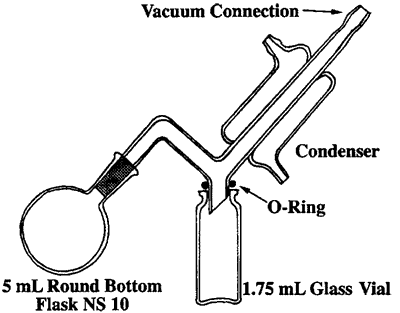
Figure 1.
Microscale vacuum distillation apparatus.
In an ongoing project to adapt microscale techniques to our basic organic chemistry course we needed a simple, inexpensive, and highly efficient vacuum distillation apparatus. Several reactions give liquid products (usually in the 0.2–0.5 mL range) suitable for purification by distillation. Since common microscale equipment was rather inefficient and retained a large fraction (0.07–0.14 mL) of the material after distillation, we designed a new apparatus (Fig. 1). Several test runs in our equipment with diethylmalonate gave a good yield of distilled material and only a small amount remained (ca. 0.025 mL). The apparatus (Fig. 1) is made of a tube with an NS 10 joint that is bent twice and fused with a water-cooled condenser. The tube is then connected to a vacuum pump or water aspirator. The distillate is collected in a 1.75-mL glass vial that is tightened with an O-ring or a rubber gasket, simply made from a rubber sheet using a cork borer. The purity of the product is controlled by refractive index or a microscale boiling point determination. This apparatus has been used in our student laboratories with very good results. The distillation is fast and efficient and the equipment is very easy to handle.